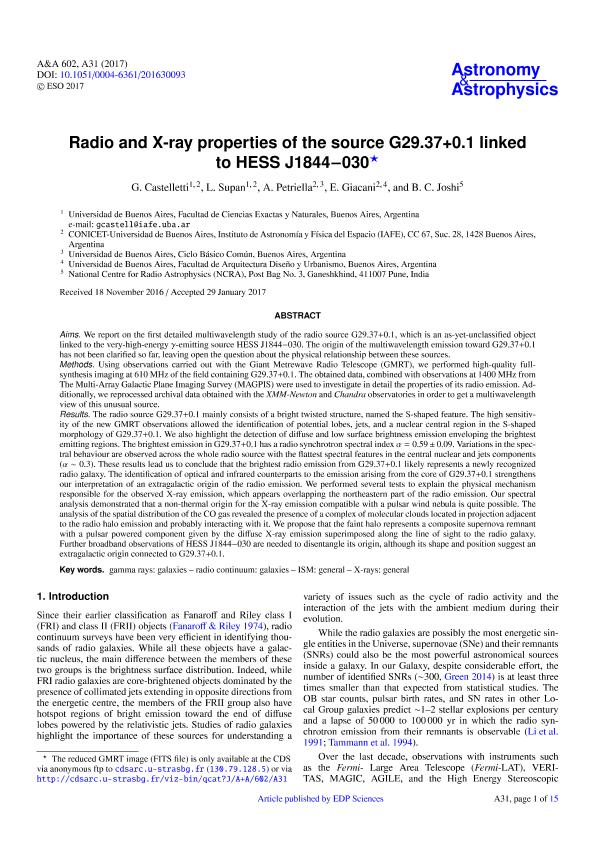Artículo
Radio and X-ray properties of the source G29.37+0.1 linked to HESS J1844-030
Castelletti, Gabriela Marta ; Supán, Jorge Leonardo
; Supán, Jorge Leonardo ; Petriella, Alberto
; Petriella, Alberto ; Giacani, Elsa Beatriz
; Giacani, Elsa Beatriz ; Joshi, B. C.
; Joshi, B. C.
 ; Supán, Jorge Leonardo
; Supán, Jorge Leonardo ; Petriella, Alberto
; Petriella, Alberto ; Giacani, Elsa Beatriz
; Giacani, Elsa Beatriz ; Joshi, B. C.
; Joshi, B. C.
Fecha de publicación:
01/2017
Editorial:
EDP Sciences
Revista:
Astronomy and Astrophysics
ISSN:
0004-6361
Idioma:
Inglés
Tipo de recurso:
Artículo publicado
Clasificación temática:
Resumen
Aims: We report on the first detailed multiwavelength study of the radio source G29.37+0.1, which is an as-yet-unclassified object linked to the very-high-energy γ-emitting source HESS J1844-030. The origin of the multiwavelength emission toward G29.37+0.1 has not been clarified so far, leaving open the question about the physical relationship between these sources. Methods: Using observations carried out with the Giant Metrewave Radio Telescope (GMRT), we performed high-quality full-synthesis imaging at 610 MHz of the field containing G29.37+0.1. The obtained data, combined with observations at 1400 MHz from The Multi-Array Galactic Plane Imaging Survey (MAGPIS) were used to investigate in detail the properties of its radio emission. Additionally, we reprocessed archival data obtained with the XMM-Newton and Chandra observatories in order to get a multiwavelength view of this unusual source. Results: The radio source G29.37+0.1 mainly consists of a bright twisted structure, named the S-shaped feature. The high sensitivity of the new GMRT observations allowed the identification of potential lobes, jets, and a nuclear central region in the S-shaped morphology of G29.37+0.1. We also highlight the detection of diffuse and low surface brightness emission enveloping the brightest emitting regions. The brightest emission in G29.37+0.1 has a radio synchrotron spectral index α = 0.59 ± 0.09. Variations in the spectral behaviour are observed across the whole radio source with the flattest spectral features in the central nuclear and jets components (α 0.3). These results lead us to conclude that the brightest radio emission from G29.37+0.1 likely represents a newly recognized radio galaxy. The identification of optical and infrared counterparts to the emission arising from the core of G29.37+0.1 strengthens our interpretation of an extragalactic origin of the radio emission. We performed several tests to explain the physical mechanism responsible for the observed X-ray emission, which appears overlapping the northeastern part of the radio emission. Our spectral analysis demonstrated that a non-thermal origin for the X-ray emission compatible with a pulsar wind nebula is quite possible. The analysis of the spatial distribution of the CO gas revealed the presence of a complex of molecular clouds located in projection adjacent to the radio halo emission and probably interacting with it. We propose that the faint halo represents a composite supernova remnant with a pulsar powered component given by the diffuse X-ray emission superimposed along the line of sight to the radio galaxy. Further broadband observations of HESS J1844-030 are needed to disentangle its origin, although its shape and position suggest an extragalactic origin connected to G29.37+0.1.
Archivos asociados
Licencia
Identificadores
Colecciones
Articulos(IAFE)
Articulos de INST.DE ASTRONOMIA Y FISICA DEL ESPACIO(I)
Articulos de INST.DE ASTRONOMIA Y FISICA DEL ESPACIO(I)
Citación
Castelletti, Gabriela Marta; Supán, Jorge Leonardo; Petriella, Alberto; Giacani, Elsa Beatriz; Joshi, B. C.; Radio and X-ray properties of the source G29.37+0.1 linked to HESS J1844-030; EDP Sciences; Astronomy and Astrophysics; 602; A31; 1-2017; 1-15
Compartir
Altmétricas



